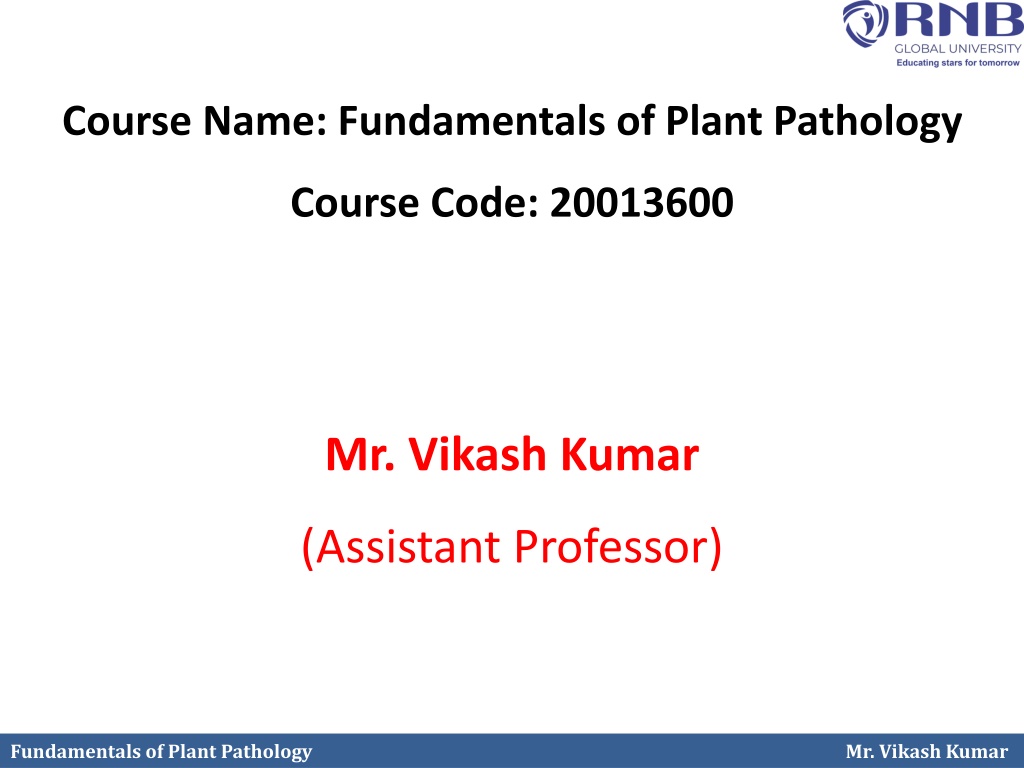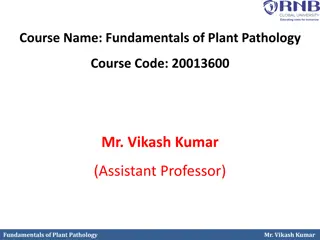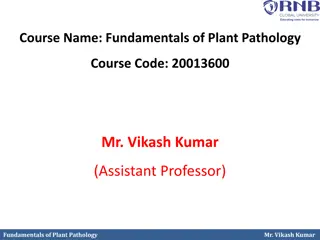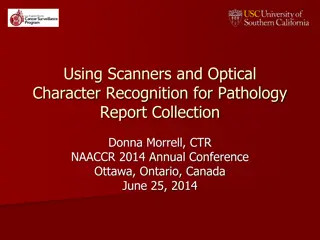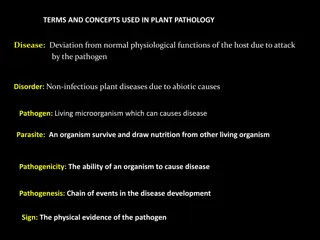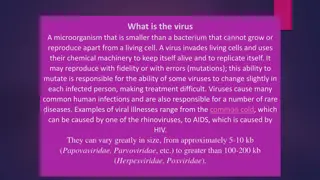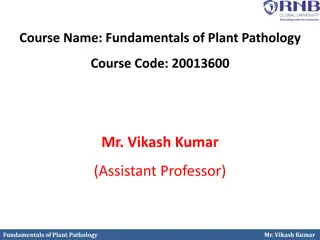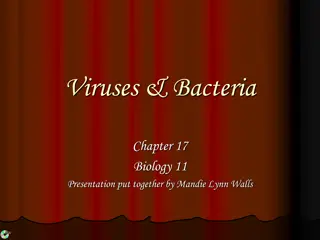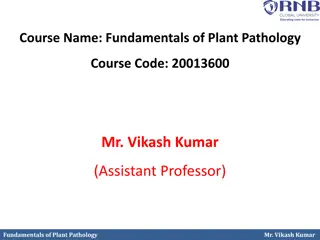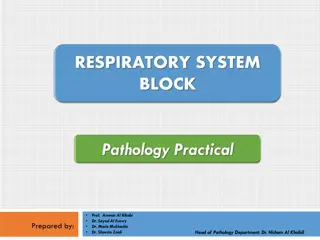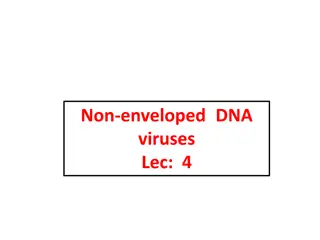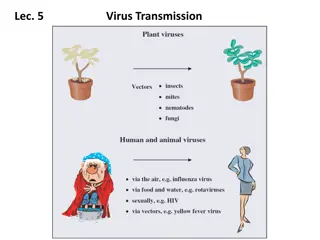Exploring the Fundamentals of Plant Pathology: Understanding Viruses in Plant Diseases
Delve into the world of plant pathology with Mr. Vikash Kumar, as you learn about the nature, structure, and transmission of viruses affecting plants. Explore the important characteristics of plant viruses, their unique properties, and how they interact within plant cells. Gain insights into viral diseases such as potato leaf roll, leaf curl of tomato, and mosaic diseases, and discover key concepts in plant virology. Uncover the groundbreaking research by pioneers like Adolf Mayer and W.M. Stanley that paved the way for understanding these microscopic pathogens.
Download Presentation

Please find below an Image/Link to download the presentation.
The content on the website is provided AS IS for your information and personal use only. It may not be sold, licensed, or shared on other websites without obtaining consent from the author. Download presentation by click this link. If you encounter any issues during the download, it is possible that the publisher has removed the file from their server.
E N D
Presentation Transcript
Course Name: Fundamentals of Plant Pathology Course Code: 20013600 Mr. Vikash Kumar (Assistant Professor) Fundamentals of Plant Pathology Mr. Vikash Kumar
Course Objectives 1: Name and identify different Diseases, nature of pathogens and different strategies for management of plant diseases. 2: Outline concepts, nomenclature, classification and characters of pathogens 3: Apply different principles and methods for plant disease management. 4: Take a part in identification of diseases and marketing of relevant pesticides. 5: Conclude methods to diagnose and manage a wide range of plant diseases. Fundamentals of Plant Pathology Mr. Vikash Kumar
Viruses: nature, structure and transmission Fundamentals of Plant Pathology Mr. Vikash Kumar
Adolf Mayer described a disease of tobacco called mosaic kranheit (tobacco mosaic). Iwanowaski Filtrate TMV infected leaf juice extract from bacterial retaining filter. M.W. Beijerinck - He believed it to be contagium vivum fluidum (infectious living fluid). He was the first to use the term virus, which is the Latin word means poison. Also called father of plant virology. Crystallization of virus done by W. M. Stanley (1935) proved that viruses can be made as crystals. He got Nobel Prize in 1946. Fundamentals of Plant Pathology Mr. Vikash Kumar
VIRUSES They are infections agents made up of one type of nucleic acid (RNA or DNA) enclosed in a protein coat. Examples of viral diseases of plants are: potato leaf roll, leaf curl of tomato and chillies, and mosaic disease of many plants. Virus: vira (poison fluid) sanskrit - visha (poison) sub microscopic, infectious entities, multiply intracellularly, potentially pathogenic. Plant Virology : study of plant viruses Fundamentals of Plant Pathology Mr. Vikash Kumar
IMPORTANT CHARACTERISTICS OF PLANT VIRUSES: Ultra microscopic Pass through bacterial proof filters hence called filterable agents Obligate Parasites, highly infectious and host specific Movement of virus in cell through plasmodesmata. Dependent on host protein synthesizing machinery for replication and multiplication. Virions technical name of virus/virus particle Virion consist of nucleic acid protected by protein coat (capsid) i.e., chemically nucleoproteins Genome: Majority - RNA Eg. Tobamo virus (Tobacco mosaic virus) Few - DNA Eg. Caulimovirus (cauliflower mosaic virus) Fundamentals of Plant Pathology Mr. Vikash Kumar
Shape of viruses 1. Rod (end open) a. Rigid rod eg.TMV b. Flexible rod eg. Potato virus-X (Potex) 2. Polyhedral virus (spherical/icosahedron) Eg. Tobacco necrosis & Cucumber mosaic virus 3. Bacilliform (end covered by protein sub units) Eg. Alfalfa mosaic virus 4. Gemini virus Leaf curl virus, maize streak virus Structure of Tobacco mosaic virus Tobacco mosaic virus (TMV) is a plant virus that belongs to the genus Tobamovirus. The infection creates a mosaic like pattern, mottling and discoloration of the leaves. Fundamentals of Plant Pathology Mr. Vikash Kumar
Structure The tobacco mosaic virus (TMV) has a rod-like appearance that is 300 nm long with a diameter of 18 nm. It is covered by a protein shell called capsid that encloses the virus s genetic material. The genetic material is a single-stranded RNA molecule. The capsid is made up of 2130 molecules of coat proteins that assemble in a rod-like helical structure possessing 16.3 proteins per helix turn. The RNA is found in a coiled manner inside the capsid coat and is made up of approximately 6395 nucleotides. Below is a simple and labelled diagram of TMV for your better understanding. Fundamentals of Plant Pathology Mr. Vikash Kumar
Fundamentals of Plant Pathology Mr. Vikash Kumar
METHODS OF TRANSMISSION OF PLANT VIRUSES: (A) Artificial transmission 1. Mechanically through Sap: Rubbing the sap from infected leaves to healthy leave Eg. Tobacco and tomato mosaic virus 2. Grafting: Grafting of plants from infected to healthy. Eg. Citrus tristeza, Tobacco leaf curl (B) Natural transmission 1. Contact: physical/aerial contact of leaves Eg. TMV, PV-X 2. Seed/ propagative material: a. Internal seed borne viruses - Eg. Bean, cowpea, soybean mosaic virus b. Vegitatively propagating material - Eg. Sugarcane mosaic virus setts PV-X tubers Fundamentals of Plant Pathology Mr. Vikash Kumar
3. Phanerogamic parasites virus transfer between unrelated hosts Eg. Dodder, Cuscuta campestris Tomato bushy stunt virus 4. Soil: Virus viable for 6 years in soil Eg. Wheat mosaic virus 5. Fungi - Eg. Synchytrium endobioticum PV-X, Olpidium brassicae- Tobacco necrosis virus 6. Nematodes - NEPO viruses (Nematode transmitted polyhedral viruses) Eg. Xiphinema index- Grape fan leaf virus Longidorus attenuatus - Tomato black ring virus Fundamentals of Plant Pathology Mr. Vikash Kumar
NETU viruses (Nematode transmitted Tubular viruses) Eg. Trichodorus cylindricus - Tobacco rattle virus 7. Insect vectors: Most potential vectors Vector Any living organism that transmits a parasite is called vector. Insects with sucking mouth parts more efficient than biting and chewing mouth parts. Eg. Onion yellow dwarf virus by more than 50 species of aphids Eg: Myzus persicae (aphid) transmits more than 50 viruses Fundamentals of Plant Pathology Mr. Vikash Kumar
DISEASE/ VIRUS INSECT 1. Rice tungro/ waika virus - Nephotettix apicalis (leaf hopper ) 2. Redgram sterility mosaic-Aceria cajani (mite) 3. Tomato &tobacco leaf curl- Bemisia tabaci (white fly) 4. Yellow mosaic of pulses Bemisia tabaci 5. Bunchy top of banana- Pentalonia nigronervosa (aphid) 6. Bhendi yellow vein mosaic-Bemisia tabaci 7. Tomato spotted wilt virus-Thrips tabaci (thrips) 8. Potato leaf roll- Myzus persicae ( aphid ) Fundamentals of Plant Pathology Mr. Vikash Kumar
Thank You Fundamentals of Plant Pathology Mr. Vikash Kumar
